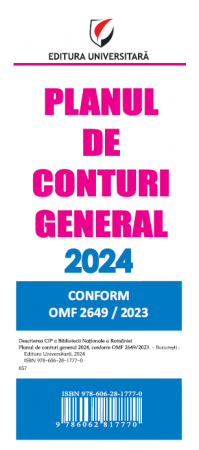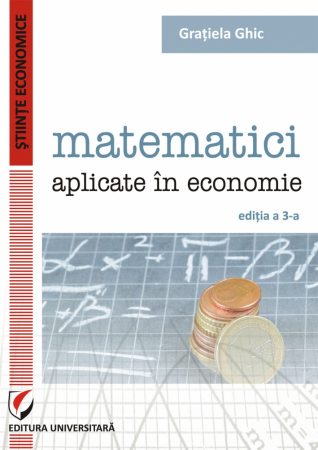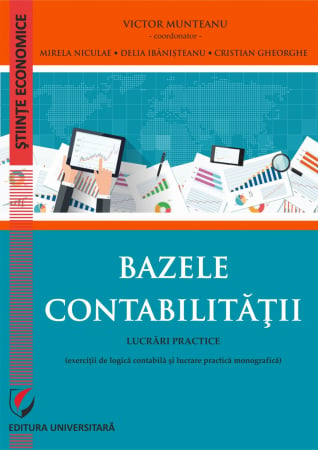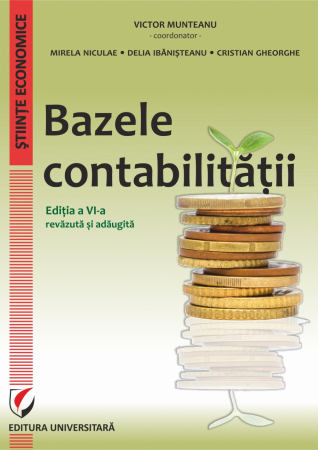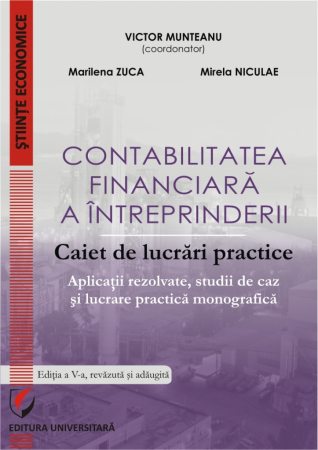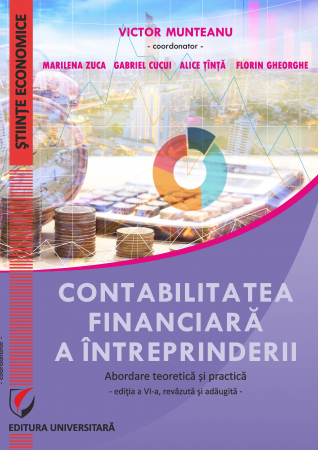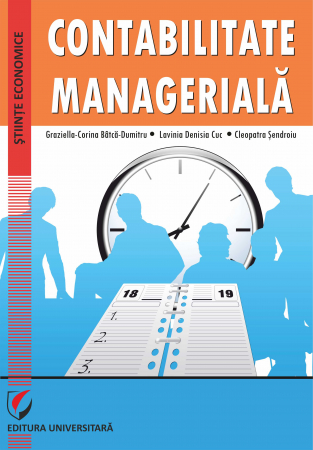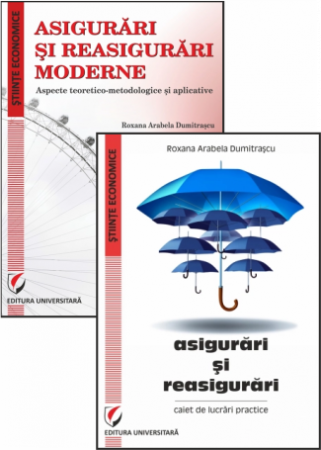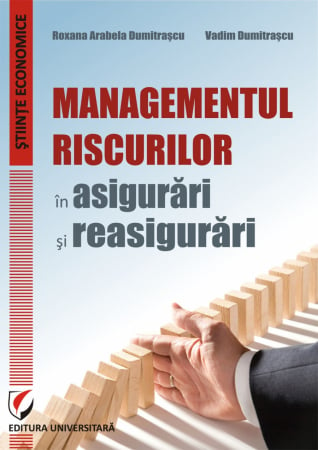6359.png) Simple and Multiple Regression Models - A Matrix Approach. Simple and multiple regression models - A matrix approach - Emilia Gogu, Nicolae Barsan-Pipu
Simple and Multiple Regression Models - A Matrix Approach. Simple and multiple regression models - A matrix approach - Emilia Gogu, Nicolae Barsan-Pipu
6359.png)
ISBN: 978-606-28-0611-8
DOI: 10.5682/9786062806118
Publisher year: 2017
Pages: 140
Publisher: Editura Universitară
Author: Emilia Gogu, Nicolae Barsan-Pipu
- Description
- Download (1)
- More details
- Authors
- Reviews (0)
Econometrics is a relatively new field of complex knowledge and multiple valences in the sphere of mathematics, economics, statistics and why not, of computer science. Therefore, the systemic vision of econometric research of economic phenomena requires interdisciplinarity in which analysis of interdependence of factors occupies a central place.
By combining the statistical and mathematical methods with the theoretical peculiarities of the political economy, econometrics meets both the valences of an applied economic research and the fundamental theory of general theory.
To understand the complexity and variety of phenomena, an econometric characterization is required by using arsenal of methods and analysis techniques in time, space and interdependence. In econometrics, however, this is evidenced by a specific methodology and a concrete way of interpreting or approaching the conclusions and decision-making. The information obtained through the analysis of multiple interdependencies contains mostly concrete points of view, thus facilitating the understanding of the phenomena as a whole. This is particularly important for establishing short, medium or long-term policies.
For this purpose, this paper interferes with the content and structure of a scientific and applied material, by observing the research stages, as follows:
- identify the subject, the particularities and the theoretical elements of econometrics;
- the processes, techniques and econometrics methods are iterated;
- all the stages of econometric modeling are presented and exemplified in a logical sequence;
- materializes a concrete and overall analysis of economic phenomena and processes.
The present paper can be considered as a tool for studying and applying simple and multiple regression models of economic phenomena and processes through a synthetic manner.
By content, the paper has a methodological, theoretical and applicative character. The "theory-case study" form under which the work is exposed allows, on the one hand, a better orientation of the reader in the field of economic process analysis and, on the other hand, corresponds to the logic and content of a specialized work.
The book is presented in an accessible way, in order to facilitate the understanding of the econometric mechanism in order to carry out complex studies. The information generated by the econometric processing presented in the case studies will help readers to properly understand and evaluate the correlation between phenomena.
Through this synthesis paper, the authors aimed at presenting the econometric modeling process of data in a matrix approach, using the most appropriate methods to obtain information necessary for knowledge and decision-making.
This specialized work is addressed to researchers, statisticians and future specialists in different fields: management, quality engineering, sociology, psychology, medicine, all interested in using efficient means of analysis and knowledge of complex variables in time and space.
The authors thank those who, through suggestions and suggestions, have contributed and will contribute to the improvement of the content and quality of this specialized paper.
The authors
-
Simple and Multiple Regression Models - A Matrix Approach. Modele de regresie simpla si multipla - O abordare matriceala
Download
Prefata /xv
Capitolul 1: Concepte generale in econometrie /71
1.1 Definirea si etimologia termenului de econometrie /71
1.2 Obiectivele si etapele econometriei /72
1.3 Concepte de baza / 73
1.3.1 Variabile economice /73
1.3.2 Tipuri de date /73
1.4 Concepte cheie /76
Capitolul 2: Modele econometrice /77
2.1 Conceptul de model econometric/ 77
2.2 Tipuri de modele econometrice /78
2.2.1 Modele unifactoriale si modele multifactoriale /78
2.2.2 Modele liniare si modele neliniare /79
2.3 Pasii modelului econometric / 81
2.4 Concepte cheie /84
Capitolul 3: Modele de regresie simpla / 85
3.1 Componentele modelului de regresie simpla / 85
3.1.1 Conceptul de “regresie” / 85
3.1.2 Terminologie pentru modelul de regresie simpla /88
3.1.3 Modelul aleator de regresie simpla/ 88
3.4 Ipotezele modelului de regresie liniara simpla/ 89
3.5 Concepte cheie / 91
Capitolul 4: Estimare si inferenta in modelele de regresie simpla ./92
4.1 Estimarea matriceala in modelul de regresie simpla /92
4.1.1 Definitii si notatii/ 92
4.1.2 Estimarea matriceala a parametrilor modelului de regresie simpla /94
4.2 Inferenta matriceala in modelul de regresie simpla/ 97
4.2.1 Testarea matriceala a ipotezelor asupra parametrilor modelului de regresie simpla / 97
4.2.3 Testul F/ 100
4.2.4 Analiza matriceala a valorilor reziduale in modelul de regresie simpla/ 101
4.3 Concepte cheie/ 102
Capitolul 5: Estimare si inferenta in modelele de regresie multipla / 103
5.1 Estimarea matriceala in modelul de regresie multipla/ 103
5.1.1 Definitii si notatii / 103
5.1.2 Estimarea matriceala a parametrilor modelului de regresie multipla/ 105
5.2 Inferenta matriceala in modelul de regresie multipla / 108
5.2.1 Testarea matriceala a ipotezelor asupra parametrilor modelului de regresie multipla / 108
5.2.2 Analiza matriceala a valorilor reziduale in modelul de regresie multipla / 116
5.3 Concepte cheie/ 120
Capitolul 6: Modele de regresie neliniare/ 121
6.1 Modele de regresie polinomiala /121
6.1.1 Definitii si notatii /121
6.1.2 Estimarea matriceala a parametrilor modelului de regresie polinomiala /122
6.2 Modele de regresie cu interactiune/ 126
6.2.1 Definitii si notatii / 126
6.1.2 Estimarea matriceala a parametrilor modelului de regresie cu interactiune /126
6.3 Concepte cheie/129
Capitolul 7: Analiza modelelor de regresie simpla si multipla in Excel / 130
7.1 Analiza modelului de regresie simpla in Excel /130
7.1.1 Optiunea Regression din Excel / 130
7.1.2 Functia Linest din Excel /133
7.2 Analiza modelului de regresie multipla in Excel /134
7.2.1 Optiunea Regression din Excel pentru regresia multipla /134
7.2.2 Functia LINEST din Excel pentru regresia multipla/134
7.2.3 Optiunea SOLVER din Excel pentru regresia multipla /135
7.3 Concepte cheie / 136
Bibliografie /137
Preface /xi
Chapter 1: General concepts in econometrics / 1
1.1 Definition and etymology of the term of econometrics/1
1.2 Objectives and stages of econometrics/2
1.3 Basic concepts /3
1.3.1 Economic variables /3
1.3.2 Types of data /3
1.4 Key concepts /6
Chapter 2: Econometric models / 7
2.1 The concept of econometric model /7
2.2 Types of econometric models /8
2.2.1 Univariate and multivariate models/ 8
2.2.2 Linear models and nonlinear models/ 9
2.3 Steps of the econometric model/ 11
2.4 Key concepts/ 14
Chapter 3: Simple regression models/ 16
3.1 The components of the simple regression model / 16
3.1.1 The concept of "regression" /16
3.1.2 Terminology for the simple regression model /19
3.1.3 The random simple regression model/19
3.2 Hypotheses of the simple linear regression model /20
3.3 Key concepts /22
Chapter 4: Estimation and inference in simple regression models / 23
4.1 Matrix estimation in the simple regression model/ 23
4.1.1 Definitions and notations /23
4.1.2 Matrix estimation of simple regression model parameters /25
4.2 Matrix inference in the simple regression model /28
4.2.1 Matrix testing of hypotheses on parameters of the simple regression model / 28
4.2.3 F test /31
4.2.4 Matrix analysis of residual values in the simple regression model / 32
4.3 Key concepts/33
Chapter 5: Estimation and inference in multiple regression models /34
5.1 Matrix estimation in the multiple regression model /34
5.1.1 Definitions and notations / 34
5.1.2 Matrix estimation of multiple regression model parameters / 36
5.2 Matrix inference in the multiple regression model /38
5.2.1 Matrix testing of hypotheses on multiple regression model parameters/38
5.2.2 Matrix analysis of residual values in the multiple regression model / 47
5.3 Key concepts ./ 51
Chapter 6: Nonlinear regression models /52
6.1 Polynomial regression models / 52
6.1.1 Definitions and notations / 52
6.1.2 Matrix estimation of the polynomial regression model parameters/ 53
6.2 Regression models with interaction /57
6.2.1 Definitions and notations /57
6.1.2 Matrix estimation of the parameters of the regression model with interaction / 57
6.3 Key concepts / 60
Chapter 7: Analysis of simple and multiple regression models in Excel/ 61
7.1 Analysis of simple regression model in Excel / 61
7.1.1 The Regression option in Excel /61
7.1.2 The Linest function in Excel / 64
7.2 Analysis of multiple regression model in Excel / 65
7.2.1 The Regression option in Excel for multiple regression /
7.2.2 The LINEST function in Excel for multiple regression /65
7.2.3 SOLVER option in Excel for multiple regression / 66
7.3 Key concepts /67
Bibliography / 68
Nicolae Barsan-Pipu

![Simple and Multiple Regression Models - A Matrix Approach. Simple and multiple regression models - A matrix approach - Emilia Gogu, Nicolae Barsan-Pipu [1] Simple and Multiple Regression Models - A Matrix Approach. Simple and multiple regression models - A matrix approach - Emilia Gogu, Nicolae Barsan-Pipu [1]](https://gomagcdn.ro/domains/editurauniversitara.ro/files/product/large/simple-and-multiple-regression-models-a-matrix-approach-modele-de-regresie-simpla-si-multipla-o-abordare-matriceala-410-242101.jpg)
